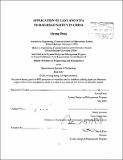Application of CAST and STPA to railroad safety in China
Author(s)
Dong, Airong, S.M. Massachusetts Institute of Technology
DownloadFull printable version (6.640Mb)
Alternative title
Application of Causal Analysis based on STAMP and System Theoretic Process Analysis to railroad safety in China
Application of Causal Analysis based on System-Theoretic Accident Model and System Theoretic Process Analysis to railroad safety in China
Other Contributors
Massachusetts Institute of Technology. Engineering Systems Division.
Advisor
Nancy Leveson.
Terms of use
Metadata
Show full item recordAbstract
The accident analysis method called STAMP (System-Theoretic Accident Model), developed by Prof. Nancy Leveson from MIT, was used here to re-analyze a High Speed Train accident in China. On July 23rd, 2011, 40 people were killed and 120 injured on the Yong-Wen High Speed Line. The purpose of this new analysis was to apply the broader view suggested by STAMP, considering the whole socio-technological system and not only equipment failures and operators mistakes, in order to come up with new findings, conclusions and recommendations for the High Speed Train System in China. The STAMP analysis revealed that the existing safety culture in the whole train organization, the Ministry of Railway and all its sub organizations in both the Train Development and Train Operation channels, do not meet the safety challenges involved in a high risk system like this- running frequent trains on the same line at 250km/h, with hundreds of passenger on board. The safety hazards were not systematically analyzed (not at the top level nor at the design level), safety constraints and safety requirements were very vaguely phrased, and no real enforcement was applied on safe design and implementation nor on safe operation. It looks like no clear policy on the performance/safety dilemma existed, nor the necessary safety education and training. Following from the STAMP analysis, one of the major recommendations in this thesis is to create a professional Train Safety Authority at the highest level, to be in charge of creating and supervising the rules for both Engineering and Operations, those two being highly interrelated with respect to safety. Specific Control Structures are recommended too, along with some detailed technical recommendations regarding the fail-safe design of the equipment involved in the accident. Another major recommendation is to design the safety critical systems, like the signaling control system using STPA ((System Theoretic Process Analysis), a hazard analysis technique. In the second part of this thesis, STPA is applied to another signaling system-Communication Based Train Control (CBTC) system-which is similar to the one presented in the first part. The primary goal of STPA is to include the new causal factors identified in STAMP that are not handled by the older techniques. It aims to identify accident scenarios that encompass the entire accident process, including design errors, social, organizational, and management factors contributing to accidents. These are demonstrated in the STPA analysis section.
Description
Thesis (S.M. in Engineering and Management)--Massachusetts Institute of Technology, Engineering Systems Division, System Design and Management Program, 2012. Cataloged from PDF version of thesis. Includes bibliographical references (p. 83-84).
Date issued
2012Department
System Design and Management Program.; Massachusetts Institute of Technology. Engineering Systems DivisionPublisher
Massachusetts Institute of Technology
Keywords
System Design and Management Program., Engineering Systems Division.